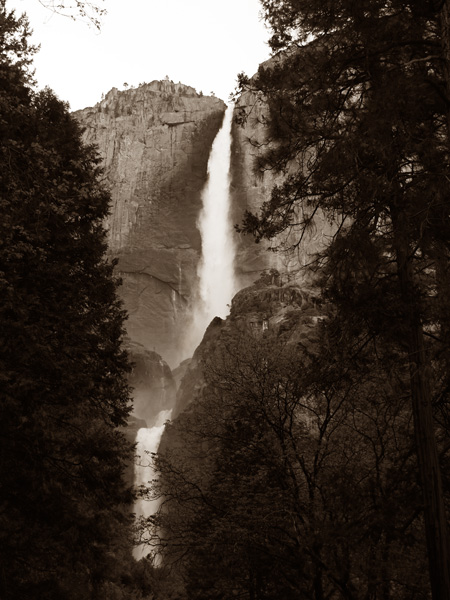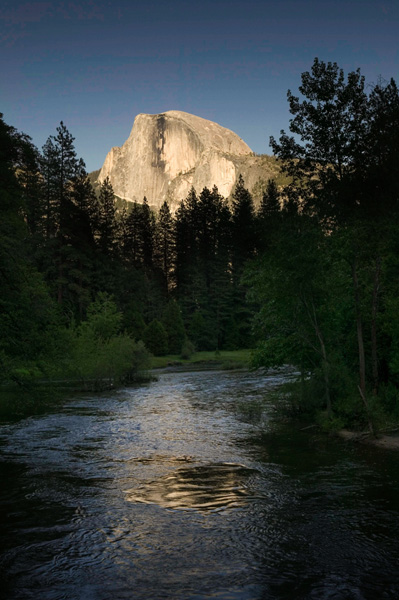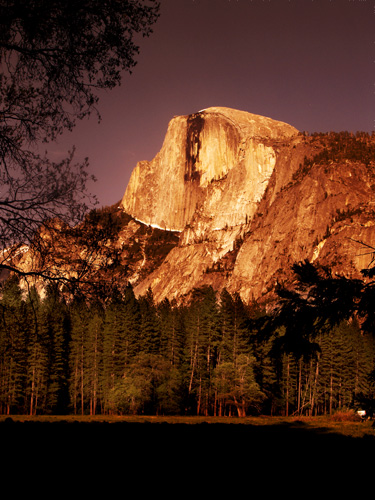YOSEMITE IN MAY
By Clive Branson
By the time I reach Coarsegold, a hiccup of a town infested by former bikers and hippies now operating flea markets of t-shirts and tie-die merchandise, it has been a four-and-a-half hour drive from Cambria. RVs are reconfigured like circled wagons and used as kiosks selling knick-knacks beside posters of bikini-clad females postulating beside beer products. The only thing missing is a hemp store. I continue onwards and slowly ascend to the town of Oakhurst, noted for its tacos, burgers, and zucchinis. I'm sure this backwater town depends heavily each year on another injection of summer tourists arriving, bumper-to-bumper. I eat at a grease parlour and notice the tourist brochures for the Mountain Sugar Pine Railroad, the Mercer Caverns, and the promise that Jesus loves me.
It is a small fee to enter Yosemite National Park.
At the entrance, you have the option of turning right to the Mariposa Grove and view the magnificent giant sequoias or turning left to Yosemite Park.
I have time before my expected arrival at Yosemite's Curry Village, so I venture off to explore the largest living things in the world - the Sierra Redwoods.
You can identify these giant sequoias by their swollen or buttressed base and cinnamon-colored bark.
These natural wonders are not to be confused with the smaller coast redwoods.
The Sierra Redwoods are only found in isolated pockets along the central and southern Sierra Nevada.
The Mariposa Grove claims 500 mature giant sequoias, some dating back 3,000 years and reaching staggering heights of between 5,500- and 7,000-feet.
The Grizzly Giant, is so large, with a volume of 34,005 cubic feet and 2,400 feet high, that park-rangers were able to build a pedestrian tunnel through it.
By early May, obstinate piles of snow are still nursed under a cool, deep-hued canopy of trees. The sinuous ribbon of road undulates like a bitten, dying serpent as my car plods its way up Glacier Point Road, narrowly averting tour buses bullying their way in the opposite direction. Every couple of minutes a road sign signals another ear-popping thousand-foot elevation. By 7,000 feet, all traces of snow have vanished under a radiant sun while a pine-resin fragrance fills my nostrils. The summit's view of Yosemite Valley from 8,000 feet is breathtaking. The landscape beyond seems to unfold in layers of imposing mountains, celestial waterfalls and a wide, vaporous skies. The flesh of the land is covered by stubble of prickly pine. Here, the monoculture of tourism hasn't defiled the scenery with its modern face. Everything is beautifully preserved. It is with gratitude to John Muir for his diligence, President Theodore Roosevelt for his foresight, and Amsel Adams for his inspiration that we may enjoy one of America's most majestic parks, Yosemite National Park, produced and packaged by nature.
There are over 800 miles of trails for hikers and horseback riders in Yosemite. April and May are ideal months to arrive here. The waterfalls cascade with thundering amplitude, the streams and lakes are gin clear, and though the temperatures during the day range from welcoming to hot, the evenings can be surprisingly nippy. Summer brings the crowds and the blooming flowers, but the heat saps and drains the waterfalls. Autumn displays its kaleidoscope of autumn colors and winter brings a cathedral hush, blanketing the whole scenery with snow that looks more like sugar powdering on a chocolate cake.
The road to Curry Village plunges past the tree tips of sequoias and drops into a mountain tunnel.
Upon exiting the darkness, all my senses are immediately suspended in slight disbelief. Before me, revealing all her glory,
Yosemite lies prostrated like some dazzling centerfold, and from where I stand, aptly named Tunnel View.
It is a valley of tree temples and granite skyscrapers. Just the names alone conjure up omnipotence:
Cathedral Rock, El Capitan, Bridalveil Falls, Yosemite Falls, and Sentinel Dome. To give you an idea of size, El Capitan, the world's largest granite mass, measured at three thousand feet, doubles the height of Gibraltar. The valley's geological formation can be observed from this observation point. To think that it had been submerged for two million years under a mantle of snow and ice to be revealed by a receding glacier only 14,000 years ago. The glacier was a conveyor belt of debris that clawed its way back, leaving a trench of naked peaks and smooth domes. The remaining snow and ice turned into lakes that eventually dried up and became the present day valley.
 Half Dome, the main attraction in this pantheon, displays its bold and bald granite face like some old but dignified statesman.
It is North America's sheerest cliff at only seven degrees from vertical scale.
The northwest half of the dome appears cleanly sliced off, like shaving cream removed by a razor blade.
Such a severe slice of granite makes me strongly suspect that this dissection was caused by the receding glacier, but in fact, as the glacier melted away, the 8,842-foot iconic emblem was exposed in its present state, and it has remained unaltered for 87 million years. That is until March 28, 2009, when a seismic 2.5 earthquake provoked a large rockslide, bulldozing hundreds of trees and burying a portion of Mirror Lake trail. The rock takes half-a-day to climb (10-14 hours round trip) and is off limits during an electrical storm – and for good reason; the Dome is akin to a lightning conductor. Stories recall the tragedy of a group foolhardy enough to be stranded up there on such an occurrence. On August 1985, five hikers climbed up the Dome late in the day to be met by misfortune. Trying to evade a lightning storm, four scrambled into a cave, only to be struck by two ferocious lightning bolts that instantly killed two and gravely injured the rest.
Half Dome, the main attraction in this pantheon, displays its bold and bald granite face like some old but dignified statesman.
It is North America's sheerest cliff at only seven degrees from vertical scale.
The northwest half of the dome appears cleanly sliced off, like shaving cream removed by a razor blade.
Such a severe slice of granite makes me strongly suspect that this dissection was caused by the receding glacier, but in fact, as the glacier melted away, the 8,842-foot iconic emblem was exposed in its present state, and it has remained unaltered for 87 million years. That is until March 28, 2009, when a seismic 2.5 earthquake provoked a large rockslide, bulldozing hundreds of trees and burying a portion of Mirror Lake trail. The rock takes half-a-day to climb (10-14 hours round trip) and is off limits during an electrical storm – and for good reason; the Dome is akin to a lightning conductor. Stories recall the tragedy of a group foolhardy enough to be stranded up there on such an occurrence. On August 1985, five hikers climbed up the Dome late in the day to be met by misfortune. Trying to evade a lightning storm, four scrambled into a cave, only to be struck by two ferocious lightning bolts that instantly killed two and gravely injured the rest.
The four million annual visitors that surge into Yosemite tend to concentrate within a seven-mile wedge referred to as Yosemite Valley. It is here that you have a choice (you have to book well in advance). There is a Park Service's Visitor Center, a museum, campgrounds, stores, restaurants, cafeterias, a post office, a bar, a general store, a medical center, shower facilities, hotels and an Ansel Adams Gallery. The premise behind the Park is aimed to educate, enlighten and to help visitors appreciate conservation by offering bus tours, free shuttle rides, bike and hiking paths, bird and wildlife watching, horseback riding, rafting, rock-climbing, waterfall hikes up Vernal and Nevada Falls, swimming in Mirror Lake, theatre, Ranger-led guided tours, and evening events under an indigo sky salted with stars. Accommodation ranges from canvas cabins and guest cottages to a luxury hotel. Prices can vary from $86 to $500/night based on your degree of "roughing it."
I choose Curry Village with its 183 canvas cabins. It is the largest lodging complex in Yosemite Valley. Though the cabins look like MASH units suitably, but sparsely furnished, with green, army steel-framed cots, a boudoir and a chair, it is a great deal and worth every cent. Each cabin is supplied with sheets and a blanket, but you would be well advised to bring a sleeping bag. A propane heater automatically turns on at night when the temperature dips below 55 degree Fahrenheit. The cabin is wrapped in a wooden and canvas skin. It is advised - no, demanded - that all food, soap, shampoo, and anything else with a scent be placed in a strongbox at the entrance of each cabin to prevent encounters with bears. This is no complacent afterthought for there have been stories of the four-legged carnivores ripping a car roof open like it was a sardine tin just for an orange peel.
There is something a bit unnerving about the stillness of a forest. Whatever is in it, can see you, but you can't see it. Still, it would be rare to sight a bear or a cougar, though signs do indicate visitors to be vigilant (I seem to notice these signs only at the end of the trails). Skittish mull deer graze in numbers in the meadows while eagles and turkey vultures soar above. But of all Yosemite's natural wonders, perhaps the 13 waterfalls and cascades are the most popular with visitors. The park's falls are some of the highest in the world: Yosemite Falls plunges from a total of 2,425 feet. Some of the most spectacular falls are Sentinel, Ribbon Falls and the grand-daddy of them all, Yosemite Falls, which is comprised of three separate falls. You can walk through the clouds of mist to hear the pounding of Lower Yosemite Falls, or for the adventurous and fit, hike to the top of Upper Yosemite Falls, a 3.6-mile trail that climbs 2,700 feet and takes hikers to the very precipice of the fall's edge.
Yosemite has been set aside as a national park to preserve natural scenery unmatched anywhere. It has three major features: High Sierra wildlands, groves of giant sequoias, and the fertile Yosemite Valley. But what I like most about it is that it tries not to compromise to excessive commercialism, though I'm sure it's a constant threat. The park expects you to be responsible and respectful, and in return it is interesting how visitors are overwhelmed not only by the obvious beauty but by the quality of peace found here. It's a humbling experience.
Copyright © Clive Branson 2016